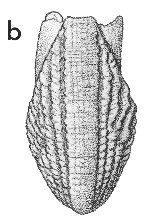
Revised descriptions of New Zealand Cenozoic Mollusca from Beu and Maxwell (1990)

 | Revised descriptions of New Zealand Cenozoic Mollusca from Beu and Maxwell (1990) | 
|
  (Pl. 23b): GS12601, O6/f40, Pinehill Stream, Waimamaku Valley, south Hokianga, Otaian (GNS) |
Beu & Maxwell (1990): Chapter 11; p. 215; pl. 23 b.
Classification: Acanthochitonidae
Description: Shell very small (largest valve seen 3.7 x 1.7 mm), each valve very long and narrow (except anterior valve, which is semicircular), all without distinction between lateral and pleural areas. Anterior valve with straight posterior margin; long insertion plate with 3 weak, shallow slits; and an evenly granulose, relatively short and wide tegmentum lacking a jugum. Median plates very long and narrow, with a clearly differentiated, smooth jugum, a lozenge-shaped tegmentum, and narrow, strongly forward-pointing sutural laminae; sculpture of longitudinal rows of granules on lateral areas; all valves seen with a posterior, strongly overhanging mucro. Posterior valve similar to median ones but a little shorter, with a very strongly overhanging, posterior mucro, and semitubular, horseshoe-shaped, unslit insertion plate directed anteriorly all around the posterior margin.
Comparison: Cryptoplax is the most common chiton under coral blocks on coral reefs throughout the tropical Pacific today; large, very long and narrow, worm-like, banded light and dark brown animals that crawl rapidly and hide in deep crevices, they don't resemble chitons until their small valves are noticed protruding from the centre of the densely spinose, bristly girdle. Other less derived species occur today under intertidal boulders around southern Australia (Iredale & Hull 1925, pp. 104-106), so the New Zealand records do not necessarily indicate the proximity of coral reefs (although fragments of hermatypic corals are recorded from Pinehill Stream). The Hokianga species appears to be nearest to C. mystica Iredale & Hull (1925, p. 104) which lives under boulders in New South Wales (C. mystica was regarded by Leloup (1940) as a form of the widespread, highly variable C. striata Lamarck, 1819). This species, and another Cryptoplax species with wider, more finely granulose valves, are the most common chiton plates in sediment washings from the Hokianga area, and are an interesting new record for New Zealand; they occur in shallow, soft-bottom facies with abundant other molluscs.
Distribution: Otaian; Waitiiti Formation, Pinehill Stream, Waimamaku Valley, south Hokianga; Otueka Hill road cutting, north Hokianga.
Cite this publication as: "A.G. Beu and J.I. Raine (2009). Revised
descriptions of New Zealand Cenozoic Mollusca from Beu and Maxwell (1990). GNS
Science miscellaneous series no. 27."
© GNS Science, 2009
ISBN
978-0-478-19705-1
ISSN 1177-2441
(Included with a PDF facsimile file
copy of New Zealand Geological Survey Paleontological Bulletin 58 in CD version
from: Publications Officer, GNS Science, P.O. Box 30368 Lower Hutt, New
Zealand)